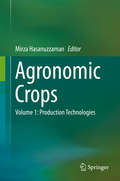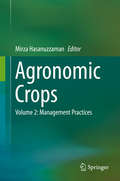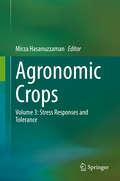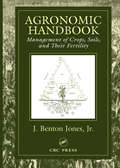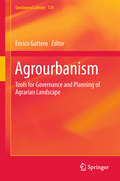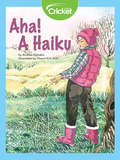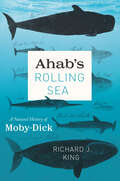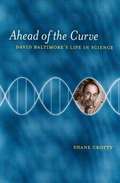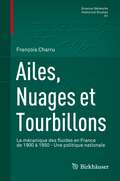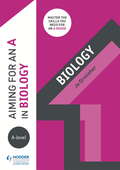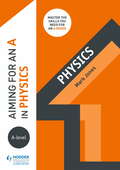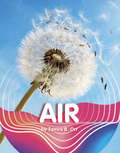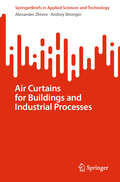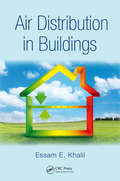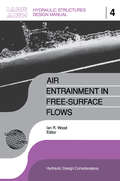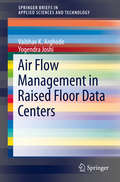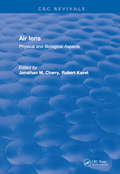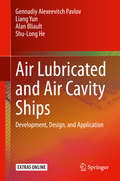- Table View
- List View
Agronomic Crops: Volume 1: Production Technologies
by Mirza HasanuzzamanAgronomic crops have been used to provide foods, beverages, fodders, fuels, medicines and industrial raw materials since the dawn of human civilization. Today, agronomic crops are being cultivated by employing scientific methods instead of traditional methods. However, in the current era of climate change, agronomic crops are subjected to various environmental stresses, which results in substantial yield loss. To meet the food demands of the ever-increasing global population, new technologies and management practices are being adopted to boost yield and maintain productivity under both normal and adverse conditions. Scientists are now exploring a variety of approaches to the sustainable production of agronomic crops, including varietal development, soil management, nutrient and water management, pest management, etc. Researchers have also made remarkable progress in developing stress tolerance in crops through different approaches. However, achieving optimal production to meet the increasing food demand is an open challenge. Although there have been numerous publications on the above-mentioned problems, and despite the extensive research being conducted on them, there is hardly any comprehensive book available. In response, this book offers a timely resource, addressing all aspects of production technologies, management practices and stress tolerance in agronomic crops in a single volume.
Agronomic Crops: Volume 2: Management Practices
by Mirza HasanuzzamanAgronomic crops have provided food, beverages, fodder, fuel, medicine and industrial raw materials since the beginning of human civilization. More recently, agronomic crops have been cultivated using scientific rather than traditional methods. However, in the current era of climate change, agronomic crops are suffering from different environmental stresses that result in substantial yield loss. To meet the food demands of the ever-increasing global population, new technologies and management practices are being adopted to boost yields and maintain productivity under both normal and adverse conditions. Further, in the context of sustainable agronomic crop production, scientists are adopting new approaches, such as varietal development, soil management, nutrient and water management, and pest management. Researchers have also made remarkable advances in developing stress tolerance in crops. However, the search for appropriate solutions for optimal production to meet the increasing food demand is still ongoing. Although there are several publications on the recent advances in these areas, there are few comprehensive resources available covering all of the recent topics. This timely book examines all aspects of production technologies, management practices and stress tolerance of agronomic crops.
Agronomic Crops: Volume 3: Stress Responses and Tolerance
by Mirza HasanuzzamanAgronomic crops have been a source of foods, beverages, fodders, fuels, medicines and industrial raw materials since the dawn of human civilization. Over time, these crops have come to be cultivated using scientific methods instead of traditional methods. However, in the era of climate change, agronomic crops are increasingly subjected to various environmental stresses, which results in substantial yield loss. To meet the food demands of the ever-increasing global population, new technologies and management practices are being adopted to boost yield and maintain productivity under both normal and adverse conditions. To promote the sustainable production of agronomic crops, scientists are currently exploring a range of approaches, which include varietal development, soil management, nutrient and water management, pest management etc. Researchers have also made remarkable progress in developing stress tolerance in crops through various approaches. However, finding solutions to meet the growing food demands remains a challenge. Although there are several research publications on the above-mentioned problems, there are virtually no comprehensive books addressing all of the recent topics. Accordingly, this book, which covers all aspects of production technologies, management practices, and stress tolerance of agronomic crops in a single source, offers a highly topical guide.
Agronomic Handbook: Management of Crops, Soils and Their Fertility
by Jr., J. JonesMany agronomic reference books either focus on a single crop, several related crops, or specific soil topics but not on a full range of both crop and soil subjects. This unique handbook covers both major agronomic fields. Containing essential data and information on the culture of the world's major agronomic grain, oil, fiber, and sugar crops grown
Agrourbanism: Tools for Governance and Planning of Agrarian Landscape (GeoJournal Library #124)
by Enrico GotteroThis book provides a much needed overview of the agrourbanism topic in the context of territorial studies. It carefully looks at rural, urban, periurban farming in both professional and unprofessional capacities as one of the main sustainable forms of land use and management. This cutting edge text explores the various forms of agricultural and urban planning, as well as the main innovations that the agro-urban approach entails in terms of governance, spatial dimensions and functions. Agrourbanism provides a breadth of information and serves as a practical study of concerns facing policy and decision makers, planners and landscape managers, as well as farmers, managers of protected areas, local authorities and local action groups. As such this book is suitable as a course accompaniment to provide an overview of the complexity of agro-urban issues.
Aha! A Haiku
by Andrea VlahakisLearn more about haiku, which are short poems, written in a style created in Japan more than 400 years ago.
Ahab's Rolling Sea: A Natural History of "Moby-Dick"
by Richard J. KingAlthough Herman Melville’s Moby-Dick is beloved as one of the most profound and enduring works of American fiction, we rarely consider it a work of nature writing—or even a novel of the sea. Yet Pulitzer Prize–winning author Annie Dillard avers Moby-Dick is the “best book ever written about nature,” and nearly the entirety of the story is set on the waves, with scarcely a whiff of land. In fact, Ishmael’s sea yarn is in conversation with the nature writing of Emerson and Thoreau, and Melville himself did much more than live for a year in a cabin beside a pond. He set sail: to the far remote Pacific Ocean, spending more than three years at sea before writing his masterpiece in 1851. A revelation for Moby-Dick devotees and neophytes alike, Ahab’s Rolling Sea is a chronological journey through the natural history of Melville’s novel. From white whales to whale intelligence, giant squids, barnacles, albatross, and sharks, Richard J. King examines what Melville knew from his own experiences and the sources available to a reader in the mid-1800s, exploring how and why Melville might have twisted what was known to serve his fiction. King then climbs to the crow’s nest, setting Melville in the context of the American perception of the ocean in 1851—at the very start of the Industrial Revolution and just before the publication of On the Origin of Species. King compares Ahab’s and Ishmael’s worldviews to how we see the ocean today: an expanse still immortal and sublime, but also in crisis. And although the concept of stewardship of the sea would have been entirely foreign, if not absurd, to Melville, King argues that Melville’s narrator Ishmael reveals his own tendencies toward what we would now call environmentalism. Featuring a coffer of illustrations and an array of interviews with contemporary scientists, fishers, and whale watch operators, Ahab’s Rolling Sea offers new insight not only into a cherished masterwork and its author but also into our evolving relationship with the briny deep—from whale hunters to climate refugees.
Ahead of the Curve: David Baltimore's Life in Science
by Shane CrottyShane Crotty's biography of David Baltimore details the life and work of one of the most brilliant, powerful, and controversial scientists of our time. Although only in his early sixties, Baltimore has made major discoveries in molecular biology, established the prestigious Whitehead Institute at MIT, been president of Rockefeller University, won the Nobel Prize, and been vilified by detractors in one of the most scandalous and protracted investigations of scientific fraud ever. He is now president of Caltech and a leader in the search for an AIDS vaccine. Crotty not only tells the compelling story of this larger-than-life figure, he also treats the reader to a lucid account of the amazing revolution that has occurred in biology during the past forty years. Basing his narrative on many personal interviews, Crotty recounts the milestones of Baltimore's career: completing his Ph. D. at Rockefeller University in eighteen months, participating in the anti--Vietnam War movement, winning a Nobel Prize at age thirty-seven for the co-discovery of reverse transcriptase, and co-organizing the recombinant DNA/genetic engineering moratorium. Along the way, readers learn what viruses are and what they do, what cancer is and how it happens, the complexities of the AIDS problem, how genetic engineering works, and why making a vaccine is a complicated process. And, as Crotty considers Baltimore's public life, he retells the famous scientific fraud saga and Baltimore's vindication after a decade of character assassination. Crotty possesses the alchemical skill of converting technical scientific history into entertaining prose as he conveys Baltimore's huge ambitions, intensity, scientific genius, attitude toward science and politics, and Baltimore's own view about what happened in the "Baltimore Affair. "Ahead of the Curve shows why with his complex personality, keen involvement in public issues, and wide-ranging interests David Baltimore has not only shaped the face of American science as we know it today, but has also become a presence in our culture.
Ailes, Nuages et Tourbillons: La mécanique des fluides en France de 1900 à 1950 - Une politique nationale (Science Networks. Historical Studies #61)
by François CharruFrench aeronautics shone brightly in the first decade of the twentieth Century, but declined after the Great War. To remedy this situation, a new Ministry of Air launched in 1929 a large national program of scientific research in fluid mechanics, including the creation of four institutes and five teaching centers in the faculties of sciences in Paris and the provinces. This visionary policy, supported by considerable means, started a quite creative period and led to important achievements notably in the fields of atmospheric turbulence, thermoconvection and wake vortices. The usual picture of a period exclusively dominated by German and British contributions (and growing North-American ones), comes out significantly revised. The fruits of this policy will allow France to play a major role in the creation, after World War II, of the International Union of Theoretical and Applied Mechanics, and are still visible today in the French teaching and research organization. Based on original materials unearthed from a variety of archival sources and scientific papers, the present book recounts this history in all its intertwined scientific, industrial, political and cultural dimensions.Peer-review recommendation: “The text is tremendously well written, and it remains clear and accessible even in its most scientifically advanced dimensions. The author is thus able to address both connoisseurs of the field, who will enjoy reading - and discovering not only scientific but also literary elements and references - and neophytes who are never left by the wayside as the chapters progress. An exceptional and original iconography usefully completes this picture, without overloading it.”L'aéronautique française, qui a tant brillé au début du XXe siècle, décline nettement après la Grande Guerre. Afin de redresser la situation, un nouveau ministère de l'Air lance alors, en 1929, un ambitieux programme en faveur de la recherche en mécanique des fluides, incluant la création de quatre instituts et cinq centres d'enseignement dans les facultés des sciences de Paris et de province. Cette politique visionnaire, dotée de moyens considérables, initie une période très dynamique et créative, en particulier dans les domaines de la turbulence atmosphérique, de la thermoconvection et des tourbillons de sillage. L'image d'un demi-siècle exclusivement dominé par les contributions allemandes et anglaises (et ensuite américaines) s'en trouve notablement transformée. Les fruits de cette politique permettront à la France de jouer un rôle majeur dans la création, après la Seconde Guerre mondiale, de l'Union internationale de mécanique théorique et appliquée, et demeurent visibles aujourd'hui encore dans les structures d'enseignement et de recherche. Fondé sur des documents originaux issus de nombreuses archives et publications, le présent livre raconte cette histoire dans ses différentes dimensions scientifique, industrielle, politique et culturelle.
Aiming for an A in A-level Biology
by Jo OrmisherExam Board: AQA, CCEA, Edexcel, OCR, WJEC/Eduqas Level: A-level Subject: Biology First teaching: September 2015 First exams: Summer 2017Master the skills you need to set yourself apart and hit the highest grades; this year-round course companion develops the higher-order thinking skills that top-achieving students possess, providing step-by-step guidance, examples and tips for getting an A grade.Written by experienced author and teacher Jo Ormisher, Aiming for an A in A-level Biology:- Helps you develop the 'A grade skills' of analysis, evaluation, creation and application- Takes you step by step through specific skills you need to master in A-level Biology, including scientific reading, quantitative and practical skills , so you can apply these skills and approach each exam question as an A/A* candidate- Clearly shows how to move up the grades with sample responses annotated to highlight the key features of A/A* answers- Helps you practise to achieve the levels expected of top-performing students, using in-class or homework activities and further reading tasks that stretch towards university-level study- Perfects exam technique through practical tips and examples of common pitfalls to avoid - Cultivates effective revision habits for success, with tips and strategies for producing and using revision resources- Supports all exam boards, outlining the Assessment Objectives for reaching the higher levels under the AQA, Edexcel, OCR, WJEC/Eduqas and CCEA specifications
Aiming for an A in A-level Biology
by Jo OrmisherExam Board: AQA, CCEA, Edexcel, OCR, WJEC/Eduqas Level: A-level Subject: Biology First teaching: September 2015 First exams: Summer 2017Master the skills you need to set yourself apart and hit the highest grades; this year-round course companion develops the higher-order thinking skills that top-achieving students possess, providing step-by-step guidance, examples and tips for getting an A grade.Written by experienced author and teacher Jo Ormisher, Aiming for an A in A-level Biology:- Helps you develop the 'A grade skills' of analysis, evaluation, creation and application- Takes you step by step through specific skills you need to master in A-level Biology, including scientific reading, quantitative and practical skills , so you can apply these skills and approach each exam question as an A/A* candidate- Clearly shows how to move up the grades with sample responses annotated to highlight the key features of A/A* answers- Helps you practise to achieve the levels expected of top-performing students, using in-class or homework activities and further reading tasks that stretch towards university-level study- Perfects exam technique through practical tips and examples of common pitfalls to avoid - Cultivates effective revision habits for success, with tips and strategies for producing and using revision resources- Supports all exam boards, outlining the Assessment Objectives for reaching the higher levels under the AQA, Edexcel, OCR, WJEC/Eduqas and CCEA specifications
Aiming for an A in A-level Chemistry
by Sarah LongshawExam Board: AQA, Edexcel, CCEA, OCR, WJEC EduqasLevel: A-levelSubject: ChemistryFirst teaching: September 2015First exams: Summer 2017 Master the skills you need to set yourself apart and hit the highest grades; this year-round course companion develops the higher-order thinking skills that top-achieving students possess, providing step-by-step guidance, examples and tips for getting an A grade.Written by experienced author and teacher Sarah Longshaw, Aiming for an A in A-level Chemistry:- Helps you develop the 'A grade skills' of analysis, evaluation, creation and application- Takes you step by step through specific skills you need to master in A-level Chemistry, including scientific reading, quantitative and practical skills, so you can apply these skills and approach each exam question as an A/A* candidate- Clearly shows how to move up the grades with sample responses annotated to highlight the key features of A/A* answers- Helps you practise to achieve the levels expected of top-performing students, using in-class or homework activities and further reading tasks that stretch towards university-level study- Perfects exam technique through practical tips and examples of common pitfalls to avoid - Cultivates effective revision habits for success, with tips and strategies for producing and using revision resources- Supports all exam boards, outlining the Assessment Objectives for reaching the higher levels under the AQA, Edexcel, OCR, WJEC/Eduqas and CCEA specifications.
Aiming for an A in A-level Chemistry
by Sarah LongshawExam Board: AQA, Edexcel, CCEA, OCR, WJEC EduqasLevel: A-levelSubject: ChemistryFirst teaching: September 2015First exams: Summer 2017 Master the skills you need to set yourself apart and hit the highest grades; this year-round course companion develops the higher-order thinking skills that top-achieving students possess, providing step-by-step guidance, examples and tips for getting an A grade.Written by experienced author and teacher Sarah Longshaw, Aiming for an A in A-level Chemistry:- Helps you develop the 'A grade skills' of analysis, evaluation, creation and application- Takes you step by step through specific skills you need to master in A-level Chemistry, including scientific reading, quantitative and practical skills, so you can apply these skills and approach each exam question as an A/A* candidate- Clearly shows how to move up the grades with sample responses annotated to highlight the key features of A/A* answers- Helps you practise to achieve the levels expected of top-performing students, using in-class or homework activities and further reading tasks that stretch towards university-level study- Perfects exam technique through practical tips and examples of common pitfalls to avoid - Cultivates effective revision habits for success, with tips and strategies for producing and using revision resources- Supports all exam boards, outlining the Assessment Objectives for reaching the higher levels under the AQA, Edexcel, OCR, WJEC/Eduqas and CCEA specifications.
Aiming for an A in A-level Physics
by Mark JonesExam Board: AQA, Edexcel, CCEA, OCR, WJEC EduqasLevel: A-levelSubject: PhysicsFirst teaching: September 2015First exams: Summer 2017Master the skills you need to set yourself apart and hit the highest grades; this year-round course companion develops the higher-order thinking skills that top-achieving students possess, providing step-by-step guidance, examples and tips for getting an A grade.Written by experienced author and teacher Mark Jones, Aiming for an A in A-level Physics:- Helps you develop the 'A grade skills' of analysis, evaluation, creation and application- Takes you step by step through specific skills you need to master in A-level Physics, including scientific reading, quantitative and practical skills, so you can apply these skills and approach each exam question as an A/A* candidate- Clearly shows how to move up the grades with sample responses annotated to highlight the key features of A/A* answers- Helps you practise to achieve the levels expected of top-performing students, using in-class or homework activities and further reading tasks that stretch towards university-level study- Perfects exam technique through practical tips and examples of common pitfalls to avoid - Cultivates effective revision habits for success, with tips and strategies for producing and using revision resources- Supports all exam boards, outlining the Assessment Objectives for reaching the higher levels under the AQA, Edexcel, OCR, WJEC/Eduqas and CCEA specifications
Aiming for an A in A-level Physics
by Mark JonesExam Board: AQA, Edexcel, CCEA, OCR, WJEC EduqasLevel: A-levelSubject: PhysicsFirst teaching: September 2015First exams: Summer 2017Master the skills you need to set yourself apart and hit the highest grades; this year-round course companion develops the higher-order thinking skills that top-achieving students possess, providing step-by-step guidance, examples and tips for getting an A grade.Written by experienced author and teacher Mark Jones, Aiming for an A in A-level Physics:- Helps you develop the 'A grade skills' of analysis, evaluation, creation and application- Takes you step by step through specific skills you need to master in A-level Physics, including scientific reading, quantitative and practical skills, so you can apply these skills and approach each exam question as an A/A* candidate- Clearly shows how to move up the grades with sample responses annotated to highlight the key features of A/A* answers- Helps you practise to achieve the levels expected of top-performing students, using in-class or homework activities and further reading tasks that stretch towards university-level study- Perfects exam technique through practical tips and examples of common pitfalls to avoid - Cultivates effective revision habits for success, with tips and strategies for producing and using revision resources- Supports all exam boards, outlining the Assessment Objectives for reaching the higher levels under the AQA, Edexcel, OCR, WJEC/Eduqas and CCEA specifications
Ain't Love Grand!: Earthworms to Elephant Seals (Chicago Shorts)
by Marty CrumpThe natural world is filled with diverse—not to mention quirky and odd—animal behaviors. Consider the male praying mantis that continues to mate after being beheaded; the insects, insects, and birds that offer gifts of food in return for sex; the male hip-pocket frog that carries his own tadpoles; the baby spiders that dine on their mother; or the starfish that sheds an arm or two to escape a predator's grasp. In Ain’t Love Grand, Marty Crump—a tropical field biologist well known for her work with the reproductive behavior of amphibians—examines the bizarre conduct of animals as they mate, parent, feed, defend themselves, and communicate. More importantly, Crump points out that diverse and unrelated animals often share seemingly erratic behaviors—evidence, Crump argues, that these natural histories, though outwardly weird, are actually successful ways of living.
Air (Earth Materials and Systems)
by Tamra B. OrrAll living things need air to survive. Air also protects Earth. Discover why air is an important part of nature!
Air Conditioning and Refrigeration Engineering (Engineering Handbooks)
by Shan K. Wang, Zalman Lavan and Paul NortonAn air conditioning system consists of components and equipment arranged in sequential order to control and maintain an indoor environment. The goal is to provide a healthy and comfortable climate with acceptable air quality while being energy efficient and cost effective. Air Conditioning and Refrigeration Engineering covers all types of systems from institutional and commercial to residential.The book supplies the basics of design, from selecting the optimum system and equipment to preparing the drawings and specifications. It discusses the four phases of preparing a project: gathering information, developing alternatives, evaluating alternatives, and selling the best solution. In addition, the author breaks down the responsibilities of the engineer, design documents, computer aided design, and government codes and standards.Air Conditioning and Refrigeration Engineering provides you with an easy reference to all aspects of the topic. This resource addresses the most current areas of interest, such as computer-aided design and drafting, desiccant air conditioning and energy conservation. It is a thorough and convenient guide to air conditioning and refrigeration engineering.
Air Curtains for Buildings and Industrial Processes (SpringerBriefs in Applied Sciences and Technology)
by Alexander Zhivov Andrey StronginThis book is based on several decades of authors’ research and practical experience in the areas of industrial and commercial buildings ventilation and energy efficiency as well as in process optimization in different types of industrial facilities. The Book discusses different types of air curtains used around the world and describes design, applications, pros and cons and examples for each type of air curtain. The book is illustrated with schematics of air curtains and pictures from their real-life implementation from around-the -world. To compare various design of air curtains, authors propose several indicators/efficiency criteria, which address effectiveness of air curtains, their energy and performance efficiency. The target audience for this book are energy and process engineers and designers of large commercial and industrial facilities, warehouses, and hangars.
Air Distribution in Buildings (Mechanical and Aerospace Engineering Series #54)
by Essam E. KhalilAir Distribution in Buildings is a concise and practical guide to air distribution system design and managing air conditioning systems in buildings. Making use of 40 years of experience in the design of air conditioning and ventilations systems, and other electromechanical services, this structured reference for built environment engineering offers
Air Entrainment in Free-surface Flow: IAHR Hydraulic Structures Design Manuals 4
by Ian R. WoodThis monograph is aimed at the practising hydraulic engineer. Work on it commenced at Professor Naudascher's instigation in 1982. Over the next six years all or some of the authors discussed progress at IAHR sponsored conferences at Esslingen, Melbourne, Lausanne and Beijing. With the authors scattered throughout the world, and all with other responsibilities, progress was bound to be slow. Completion was further delayed by the great increase in published technical literature in this area over the period 1982-1988. This literature continues to expand and with it our understanding of the air water flow phenomena. The monograph must therefore be seen as the authors' views on the state of the art around 1988. More recent references have been included for completeness.This monograph has been a joint effort with most authors making suggestions and contributions to more than one chapter. Nevertheless, the chapter authors are primarily responsible for the material in their chapters.Throughout the monograph symbols are defined when they are fist introduced and a list of symbols is included at the end of each chapter.Many other people have contributed to this monograph, but the authors would particularly like to acknowledge the assistance given by Professor John McNown who has read, commented on and improved the style of the complete monograph.
Air Flow Management in Raised Floor Data Centers (SpringerBriefs in Applied Sciences and Technology)
by Yogendra Joshi Vaibhav K. ArghodeThe Brief discuss primarily two aspects of air flow management in raised floor data centers. Firstly, cooling air delivery through perforated tiles will be examined and influence of the tile geometry on flow field development and hot air entrainment above perforated tiles will be discussed. Secondly, the use of cold aisle containment to physically separate hot and cold regions, and minimize hot and cold air mixing will be presented. Both experimental investigations and computational efforts are discussed and development of computational fluid dynamics (CFD) based models for simulating air flow in data centers is included. In addition, metrology tools for facility scale air velocity and temperature measurement, and air flow rate measurement through perforated floor tiles and server racks are examined and the authors present thermodynamics-based models to gauge the effectiveness and importance of air flow management schemes in data centers.
Air Insulation Prediction Theory and Applications (Power Systems)
by Zhibin Qiu Jiangjun Ruan Shengwen ShuThis book proposes the air insulation prediction theory and method in the subject of electrical engineering. Prediction of discharge voltage in different cases are discussed and worked out by simulation. After decades, now bottlenecks of traditional air discharge theories can be solved with this book. Engineering applications of the theory in air gap discharge voltage prediction are introduced. This book serves as reference for graduate students, scientific research personnel and engineering staff in the related fields.
Air Ions: Physical and Biological Aspects
by Jonathan M. CharryAir Ions: Physical and Biological Aspects fully develops two areas that are important for a comprehensive understanding of the subject of air ions: (1) the physical/chemical nature of ions, and (2) their potential interaction with biological systems. The reader is led through a series of none chapter, the first five of which lay the basis for understanding ions in the context of naturally and artificially created environments. The final four chapters are well situated to discuss the literature and history connected with the search for ion-induced biological effects.
Air Lubricated and Air Cavity Ships: Development, Design, and Application
by Alan Bliault Liang Yun Gennadiy Alexeevitch Pavlov Shu-Long HeAir Lubrication and Air Cavity Technology is a major development that has emerged in recent years as a means to reduce resistance and powering for many types of ships, and an efficient design for high speed marine vessels. This book introduces the mechanisms for boundary layer drag reduction and concepts studied in early research work. Air bubble and sheet lubrication for displacement vessels is outlined and the key projects introduced. Generation of low volume flow air cavities under the hull of displacement, semi displacement and planing vessels are introduced together with theoretical and empirical analysis and design methods. Resistance reduction, power reduction and fuel efficiency are covered for both displacement and high speed vessels. Air layer and air cavity effects on vessel static and dynamic stability are covered, linked to regulatory requirements such as IMO. Seaway motions and reduced impact load of high speed craft in waves are discussed including model test results. Integration of propulsion systems for optimum powering is summarized. A design proposal for a wave piercing air cavity craft is included in an appendix. A comprehensive listing of document resources and internet locations is provided for further research.
